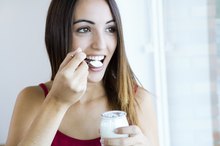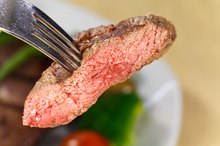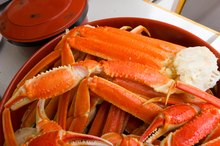What Role Do Lipids Play in the Human Body?
Lipids are fats. In the body they take the form of phospholipids, cholesterol and fatty acids. Although fats play a role in obesity and disease, your body needs a certain amount of fat to function -- also known as essential body fat. Men need at least 3 percent body fat and women need at least 12 percent body fat to ensure normal functioning. You get triglycerides and phospholipids from your diet, and you get cholesterol from your diet and your body also produces it naturally. The role that lipids play depends on the type of lipid.
Triglycerides
Triglycerides are also called blood and body fat. As body fat, triglycerides play a role in energy storage. They also provide a layer of insulation under the skin and protective cushioning around the organs. Your body also uses triglycerides to make the myelin sheaths that surround nerve cells. Myelin sheaths act as insulation and help the nerve signal travel faster along the length of the nerve. Triglycerides are solid at body temperature and are classified as saturated fats. If you have too much triglyceride in your blood, it can collect on the blood vessel walls and cause heart disease.
- Triglycerides are also called blood and body fat.
- Your body also uses triglycerides to make the myelin sheaths that surround nerve cells.
Cholesterol
What Are Phospholipids in the Diet?
Learn More
Cholesterol is another type of blood fat. Your body uses cholesterol to make steroids such as estrogen, progesterone and testosterone. Your body also makes its own supply of vitamin D and uses cholesterol for that process. Cholesterol is a major component of bile -- a soap-like substance your liver makes to break down fats. Your body breaks down cholesterol in foods but you also make it in your liver.
- Cholesterol is another type of blood fat.
- Cholesterol is a major component of bile -- a soap-like substance your liver makes to break down fats.
Types of Cholesterol
To help cholesterol mix with blood, your body packages it in small protein-covered particles called lipoproteins. Two main types of cholesterol, low-density lipoproteins and high-density lipoproteins deliver cholesterol through your bloodstream to serve its bodily functions. When you have excess LDL in your bloodstream, cholesterol gets deposited in your arteries, according to Yale School of Medicine. Cholesterol buildup can block arteries and cause heart attacks. HDL transports excess cholesterol from your cells and tissues to your liver, which uses cholesterol to produce bile. According to the National Cholesterol Education Program, desirable cholesterol numbers for adults range from 200 milligrams per deciliter for total cholesterol, less than 100 milligrams per deciliter for LDL and greater than 40 milligrams per deciliter for HDL. Because HDL protects against heart disease, higher levels, such as 60 milligrams per deciliter, offer greater protection.
- To help cholesterol mix with blood, your body packages it in small protein-covered particles called lipoproteins.
- When you have excess LDL in your bloodstream, cholesterol gets deposited in your arteries, according to Yale School of Medicine.
Phospholipids
Lipid & Glucose Levels in Blood
Learn More
Phospholipids are chains of fatty acids. Your body uses phospholipids to make cell membranes. Every part of your body is made of cells. The cell membranes serve two functions. They hold the cells together and they control what passes into and out of the cells. Your cells have a life cycle and are constantly dividing, growing and dying. Your body uses phospholipids to make the membranes of new cells and maintain the membranes of existing cells.
- Phospholipids are chains of fatty acids.
- Your body uses phospholipids to make the membranes of new cells and maintain the membranes of existing cells.
Related Articles
References
- Principles of Anatomy and Physiology; Gerard J. Tortora et al.
- UC Clermont College Biology: Lipids
- Yale School of Medicine: For Your Heart's Sake, Lower Your Cholesterol
- American Heart Association. What is cholesterol?
- Cleveland Clinic. Cholesterol: What you need to know about high blood cholesterol. May 1, 2019.
- National Center for Health Statistics. Total and high-density lipoprotein cholesterol in adults: United States, 2015–2016. October 2017.
- Centers for Disease Control and Prevention. Cholesterol.
- Barter PJ. The causes and consequences of low levels of high density lipoproteins in patients with diabetes. Diabetes Metab J. 2011;35(2):101-106. doi:10.4093/dmj.2011.35.2.101
- American Heart Association. How to get your cholesterol tested.
- Keene D, Price C, Shun-shin MJ, Francis DP. Effect on cardiovascular risk of high density lipoprotein targeted drug treatments niacin, fibrates, and CETP inhibitors: meta-analysis of randomised controlled trials including 117,411 patients. BMJ. 2014;349:g4379. doi:10.1136/bmj.g4379
- Tall HR, Rader DJ. Trials and tribulations of CETP inhibitors. Circulation Research. Oct. 10, 2017.
- U.S. Food and Drug Administration. Cholesterol: Medicines to help you.
Writer Bio
Max Whitmore is a personal trainer with more than three years experience in individual and group fitness. Whitmore has a Bachelor of Arts in English literature from the University of Cincinnati, fitness certifications and dietetics training from Cincinnati State Technical and Community College. Whitmore has written for several online publishers.









